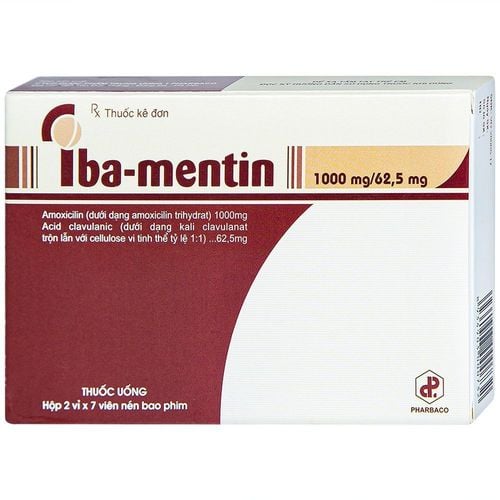This is an automatically translated article.
Spiramycin is a drug commonly used clinically to treat a number of bacterial infections. So what is the use of Spiramycin and how is it used?1. Uses of Spiramycin
Spiramycin has the main ingredient Spiramycin, which is a macrolide antibiotic with an antibacterial spectrum similar to erythromycin. Spiramycin has a bacteriostatic effect on bacteria that are dividing cells.The mechanism of action of Spiramycin is to prevent bacteria from synthesizing proteins. At serum concentrations, the drug is primarily bacteriostatic, but at high concentrations, the drug can be slow bactericidal against susceptible bacteria.
In areas where resistance is low, spiramycin is active against Gram-positive strains. However, Spiramycin is not active against Gram-negative bacteria in the intestinal tract. There has been resistance to Spiramycin, including cross-resistance between spiramycin, erythromycin and oleandomycin.
Spiramycin is indicated in the following cases:
As the drug of second choice for the treatment of infections of the respiratory tract, skin and genitals caused by susceptible strains of bacteria (in the absence of use). get beta-lactams). Prophylactic treatment of meningococcal meningitis, when rifampicin is contraindicated. Prophylaxis of recurrent acute rheumatic fever in penicillin-allergic subjects. Prophylaxis of congenital toxoplasmosis during pregnancy. Spiramycin is contraindicated in cases of known hypersensitivity to Spiramycin or to other antibiotics of the macrolide group, or to any of the excipients.
Note when using Spiramycin:
Because Spiramycin can be toxic to the liver, so it should be used with caution in people with liver dysfunction. Use with caution in people with heart disease, arrhythmia, including people with a tendency to prolong the QT interval. When initiating treatment with Spiramycin, if a generalized erythematous rash with fever is observed, the drug should be discontinued because of possible acute exanthematous pustular disease. In this case, it is contraindicated, and Spiramycin should not be used again.
2. Dosage and usage of Spiramycin
The way to take Spiramycin is as follows:Dosage and potency of Spiramycin are expressed in international units IU or mg. 1mg of Spiramyci n will equate to about 3000 IU. In oral form, Spiramycin should be taken at least 2 hours before meals or 3 hours after meals, so that the drug is not affected by food. Once Spiramycin has been used, the entire course of treatment must be followed. Spiramycin is also combined in the same preparation with metronidazole. Dosage of Spiramycin should be according to the doctor's prescription, the reference dose for specific cases is as follows:
Oral use: Adults: Use a dose of 6.0 - 9.0 million IU/day, divided 2-3 times . For severe infections, the dose can be up to 15.0 million IU/day, divided into several times. Children: Use a dose of 150,000 IU/kg body weight/ 24 hours, divided into 3 times. Prevention of meningococcal meningitis: Adults: Use a dose of 3.0 million IU / 12 hours, for 5 days. Children (1.5 million IU tablets): Use a dose of 75,000 IU / 12 hours, for 5 days. Intravenous administration (for adults): Use a slow intravenous infusion at a dose of 1.5 million IU, every 8 hours. In severe infections, the dose may be doubled. It is advisable to switch from intravenous to oral administration as soon as the clinical situation permits. When taking high doses of Spiramycin, it can cause digestive disorders such as nausea, vomiting, diarrhea. There may be a prolongation of the QT interval, which resolves with discontinuation of treatment.
In the event of an overdose of Spiramycin, the patient should have an electrocardiogram to measure the QT interval, especially in the presence of other risks (eg, hypokalemia, congenital prolongation of the QT interval, concomitant use of drugs that prolong the QT interval and/or cause torsades de pointes). There is no antidote for Spiramycin, treatment of overdose is mainly symptomatic.
3. Side effects of Spiramycin
Spiramycin rarely causes serious side effects. Common side effects of Spiramyci n include:Nausea, vomiting, indigestion, diarrhea, these effects are common when taken orally. Irritation at the injection site. Dizziness, headache. Less common side effects of Spiramycin include:
Fatigue, sweating, nosebleeds, feeling of chest pressure. Acute colitis. Temporary paresthesias, dysesthesia, pain, stiffness of muscles and joints, grogginess, burning sensation, flushing (intravenous administration). Skin rash, exanthema, urticaria. Rare side effects of Spiramycin include:
Anaphylactic reactions, superinfection due to long-term oral use of Spiramycin. Prolong the QT interval.
4. Spiramycin drug interactions with other drugs
Using Spiramycin at the same time as oral contraceptives will make the contraceptive ineffective. Spiramycin reduces blood levels of levodopa when taken concurrently. Spiramycin has little or no effect on the cytochrome P450 enzyme system in the liver. Therefore, compared with Erythromycin, Spiramycin has less interaction with drugs metabolized by this enzyme system.Please dial HOTLINE for more information or register for an appointment HERE. Download MyVinmec app to make appointments faster and to manage your bookings easily.













